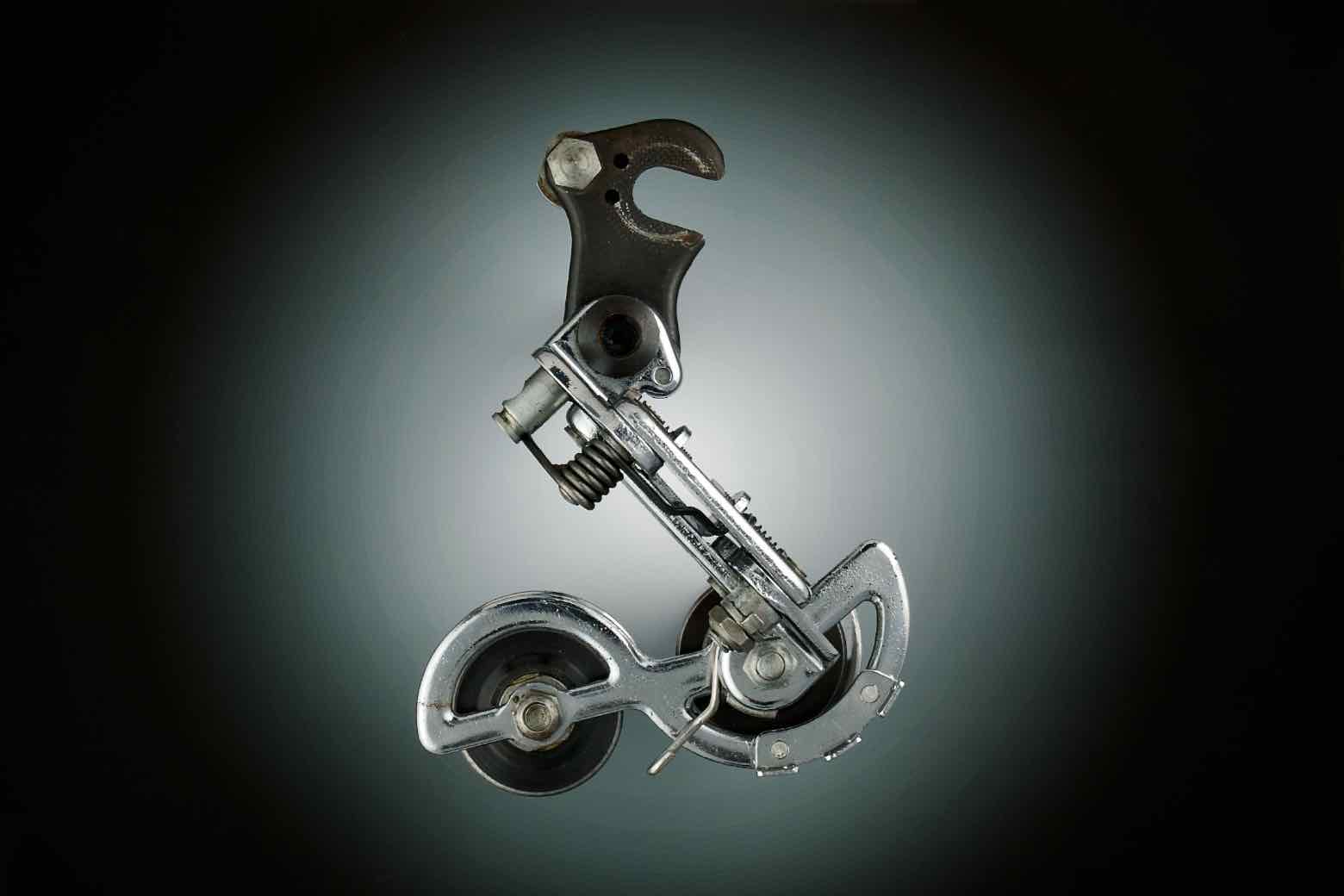
DISRAELI GEARS

After the rampant complexity of their 1958 Allvit, Huret went all out for simplicity with the 1963 Huret Svelto. It was a pared-down, all-steel economy model that was cheap to manufacture, sold in millions and had any number of imitators.
It worked OK when new, but the parallelogram lacked the torsional rigidity of more three dimensional designs, and the pivots quickly loosened destroying any pretense at precision - not so much of a problem when your main competition is the 1962 Simplex Prestige - but a serious short coming when you are up against a 1967 Shimano Skylark.
Nick Wells, a correspondent of mine who admits to a youthful yearning to ‘marry that nice blonde lady from The Champions’, writes:
“My first 'real' bike was a heavy steel 'racer' from Grattons mail order catalogue. There were only two bikes in it, one was a Raleigh, which I think had Simplex gears, and the cheaper unbranded one that I had, which had a Huret Svelto set-up.
I loved that bike, and went miles on it, and, although after a few years my chainset used to clank a little, the gears never let me down. My brother had a Carlton (with Reynolds 531 tubing) which was much lighter than mine, and it had Campagnolo Gran Sport gears, which I envied immensely. He himself though, always craved a set of Campag Record gears, so I guess neither of us was fully satisfied!”
For me the Huret Svelto is as much a part of the late 1960’s and early 1970’s as men walking on the moon, the three day week, Frank Zappa’s Hot Rats and Lord Anthony snorkel parkas with rabbit fur around the hood. Was it all a strange dream?
There is a vast and bewildering range of different variants of the Huret Svelto. Over its 13 year life it enjoyed:
Understanding all this complexity is made even more difficult because Huret does not, necessarily, use up-to-date images in its catalogues. So, for example, a 1975 catalogue may, or may not, depict the exact style of Svelto on offer in that year.
it reminds me of a conversation that I had with an engineer working in the bicycle industry in the mid 1980s. I was waxing lyrical about Toyota's Total Quality policy (religion?) of 'continuous improvement'. He (inevitably it was a he) was unimpressed.
He suggested that Toyota had excellent teams of design engineers producing excellent initial designs. These engineers were given time and resources to thoroughly challenge and develope their designs. These developed designs were then rigorously tested using formal and extensive test protocols. Finally, when the product hit production, the icing on the cake was the policy of 'continuous improvement'.
In his opinion, in the European bicycle industry, a single engineer, working alone, often initially produced a mediocre design. Virtually no attempt was made to challenge or develope this design. It was then subjected to a minimal amount of informal testing, much of it riding around the factory car park. Finally, when the product hit production, it enjoyed an endless series of desperate and slightly aimless 'improvements' in a hopeless attempt to solve fundamental problems. Both icing and cake were largely absent.
I am genuinely uncertain whether all the changes to the Svelto were desirable 'continuous improvement' or were worryingly 'desperate and slightly aimless'.
I think that this example is one of the very first, 1963, versions of the Huret Svelto. In this case it is the option with no cable adjuster. Some key features may be:
Note that, in the photo above, the p-pivot spring is not engaged, to allow the derailleur to take up a more 'normal' shape.
Browse associated documents.
French Patent # 1,346,243 - Huret
French Patent # 1,346,243 - Huret
US Trademark # 791,010 - Huret
US Trademark # 791,010 - Huret
Cycling Tour - Parts Accessory Catalog scan 4 of 4
Cycling Tour - Parts Accessory Catalog scan 4 of 4
The new derailleur Huret type Svelto scan 1 of 2
The new derailleur Huret type Svelto scan 1 of 2
Sporting Cyclist 01/1964 - Walter Flory ad
Sporting Cyclist 01/1964 - Walter Flory ad
Sporting Cyclist 08/1967 - Walter Flory ad
Sporting Cyclist 08/1967 - Walter Flory ad
New Cycling 05/1981 - '81 Derailleur Collection page 33 - scan 16 of 134
New Cycling 05/1981 - '81 Derailleur Collection page 33 - scan 16 of 134